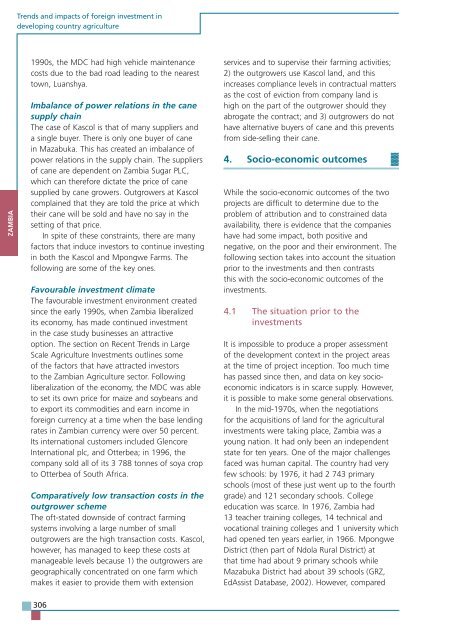TRENDS AND IMPACTS OF FOREIGN INVESTMENT IN DEVELOPING COUNTRY AGRICULTURE
TRENDS AND IMPACTS OF FOREIGN INVESTMENT IN DEVELOPING COUNTRY AGRICULTURE
TRENDS AND IMPACTS OF FOREIGN INVESTMENT IN DEVELOPING COUNTRY AGRICULTURE
Create successful ePaper yourself
Turn your PDF publications into a flip-book with our unique Google optimized e-Paper software.
ZAMBIA<br />
Trends and impacts of foreign investment in<br />
developing country agriculture<br />
1990s, the MDC had high vehicle maintenance<br />
costs due to the bad road leading to the nearest<br />
town, Luanshya.<br />
Imbalance of power relations in the cane<br />
supply chain<br />
The case of Kascol is that of many suppliers and<br />
a single buyer. There is only one buyer of cane<br />
in Mazabuka. This has created an imbalance of<br />
power relations in the supply chain. The suppliers<br />
of cane are dependent on Zambia Sugar PLC,<br />
which can therefore dictate the price of cane<br />
supplied by cane growers. Outgrowers at Kascol<br />
complained that they are told the price at which<br />
their cane will be sold and have no say in the<br />
setting of that price.<br />
In spite of these constraints, there are many<br />
factors that induce investors to continue investing<br />
in both the Kascol and Mpongwe Farms. The<br />
following are some of the key ones.<br />
Favourable investment climate<br />
The favourable investment environment created<br />
since the early 1990s, when Zambia liberalized<br />
its economy, has made continued investment<br />
in the case study businesses an attractive<br />
option. The section on Recent Trends in Large<br />
Scale Agriculture Investments outlines some<br />
of the factors that have attracted investors<br />
to the Zambian Agriculture sector. Following<br />
liberalization of the economy, the MDC was able<br />
to set its own price for maize and soybeans and<br />
to export its commodities and earn income in<br />
foreign currency at a time when the base lending<br />
rates in Zambian currency were over 50 percent.<br />
Its international customers included Glencore<br />
International plc, and Otterbea; in 1996, the<br />
company sold all of its 3 788 tonnes of soya crop<br />
to Otterbea of South Africa.<br />
Comparatively low transaction costs in the<br />
outgrower scheme<br />
The oft-stated downside of contract farming<br />
systems involving a large number of small<br />
outgrowers are the high transaction costs. Kascol,<br />
however, has managed to keep these costs at<br />
manageable levels because 1) the outgrowers are<br />
geographically concentrated on one farm which<br />
makes it easier to provide them with extension<br />
306<br />
services and to supervise their farming activities;<br />
2) the outgrowers use Kascol land, and this<br />
increases compliance levels in contractual matters<br />
as the cost of eviction from company land is<br />
high on the part of the outgrower should they<br />
abrogate the contract; and 3) outgrowers do not<br />
have alternative buyers of cane and this prevents<br />
from side-selling their cane.<br />
4. Socio-economic outcomes <br />
While the socio-economic outcomes of the two<br />
projects are difficult to determine due to the<br />
problem of attribution and to constrained data<br />
availability, there is evidence that the companies<br />
have had some impact, both positive and<br />
negative, on the poor and their environment. The<br />
following section takes into account the situation<br />
prior to the investments and then contrasts<br />
this with the socio-economic outcomes of the<br />
investments.<br />
4.1 The situation prior to the<br />
investments<br />
It is impossible to produce a proper assessment<br />
of the development context in the project areas<br />
at the time of project inception. Too much time<br />
has passed since then, and data on key socioeconomic<br />
indicators is in scarce supply. However,<br />
it is possible to make some general observations.<br />
In the mid-1970s, when the negotiations<br />
for the acquisitions of land for the agricultural<br />
investments were taking place, Zambia was a<br />
young nation. It had only been an independent<br />
state for ten years. One of the major challenges<br />
faced was human capital. The country had very<br />
few schools: by 1976, it had 2 743 primary<br />
schools (most of these just went up to the fourth<br />
grade) and 121 secondary schools. College<br />
education was scarce. In 1976, Zambia had<br />
13 teacher training colleges, 14 technical and<br />
vocational training colleges and 1 university which<br />
had opened ten years earlier, in 1966. Mpongwe<br />
District (then part of Ndola Rural District) at<br />
that time had about 9 primary schools while<br />
Mazabuka District had about 39 schools (GRZ,<br />
EdAssist Database, 2002). However, compared


